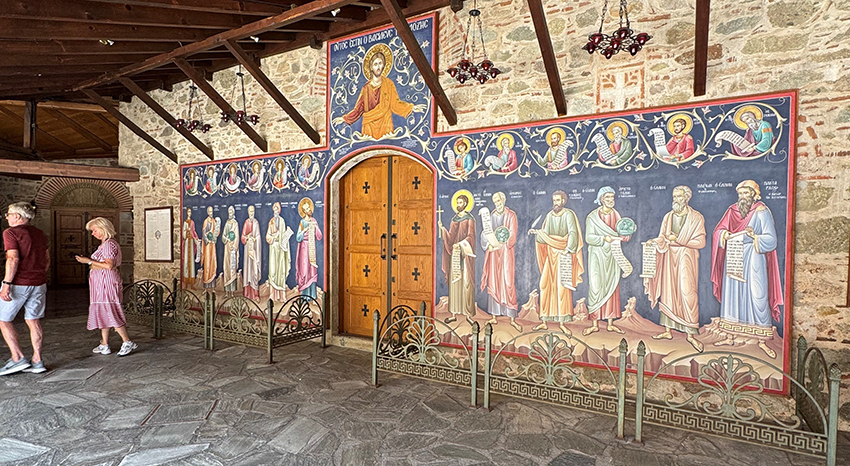Having recently travelled through Europe and visited Orthodox monasteries and convents in far-flung places such as Meteora in Greece, I was struck by the observance, liturgy and centuries of tradition in these churches and it’s contrast to Western Christian traditions.
In many parts of the Western church, programs are regularly overhauled, worship styles updated, and sermon series themed around contemporary trends. From seeker-sensitive movements to rebranding traditional services, there is often a conscious effort to make Christianity feel relevant, accessible, and appealing. This posture is not universal, but it reflects a long-standing tension in Western Christianity between preserving the theological core of the faith and adapting its expression to suit changing cultural contexts.
By contrast, the Orthodox churches of Eastern Europe and the Middle East have, for centuries, maintained a liturgical and theological consistency. Their practices—deeply shaped by the early ecumenical councils and the writings of the Church Elders—are not animated by a drive for novelty. Their faith is formed around rhythms of fasting and feasting, the Divine Liturgy, and the veneration of icons, all of which have remained remarkably stable across centuries and empires.
The Western church’s tendency toward innovation can be traced in part to the Protestant Reformation. Martin Luther’s rejection of certain Catholic practices led to a strong emphasis on sola scriptura (Scripture alone), opening the door to interpretation outside of received tradition. As theologian Alister McGrath notes in Christian Theology: An Introduction, Protestantism, especially in its evangelical forms, carries within it a degree of restlessness, partly because of its break from ecclesial continuity and partly because of its emphasis on the individual’s encounter with God. This emphasis can lead to attempts to reproduce that encounter in ways that resonate with each generation.
The Orthodox Church places the liturgy—not the sermon, nor the personality of a pastor—at the centre of Christian life. The late theologian Alexander Schmemann wrote that the liturgy is not a tool for evangelism or a means to a spiritual end; rather, it is the Church’s very life. In For the Life of the World, Schmemann asserts that “the Church must cease to present itself as a religious institution existing in a secular world,” and instead see herself as the presence of Christ in the world through her worship and sacraments. This liturgical worldview sees no need to repackage the Gospel because the Gospel is not a product to be marketed.
The Western inclination to reimagine church life is not necessarily a rejection of Christ, but often a response to declining numbers, disinterest, or disaffiliation. As sociologist Christian Smith observed in his work on American religion, especially in Soul Searching, many young people in Western churches do not inherit a deep catechesis but instead adopt a diluted moralistic therapeutic deism—a vague belief that religion is about being nice and feeling good. In response, churches introduce fresh programming and modern aesthetics to counter disengagement, often with mixed results.
It would be a mistake, however, to imply that Orthodox churches are immune to decline or cultural pressures. In traditionally Orthodox countries like Greece, Russia, and Romania, church attendance has also declined, especially among younger generations. But these churches rarely respond by changing their theology or liturgical form. Instead, they double down on catechesis, monastic witness, and continuity. Kallistos Ware, in The Orthodox Way, explains that Orthodox spirituality is not built on novelty but on transformation: “The aim of the Christian life is the acquisition of the Holy Spirit,” not the cultivation of religious experiences or attractional events.
The result is a very different posture toward time and culture. In the West, churches often act with urgency, believing the world is slipping away and the church must keep up or risk irrelevance. In Orthodoxy, the assumption is that the Church has already been given everything necessary for salvation and sanctification. The mission, then, is not to invent, but to witness—to be faithful stewards of what has been received.
The search for relevance in the Western church can lead to fruitful engagement with culture, and many local congregations have adapted creatively while maintaining theological depth. But the constant pursuit of what is next can also thin out the tradition and leave people rootless. If each generation must reinvent the church, then there is little continuity in worship, theology, or community.
The Orthodox approach, while not without its own limitations, demonstrates the possibility of long-term fidelity in the face of change. Rather than assuming the problem lies in outdated forms, it begins with the conviction that God has already acted decisively in Christ and continues to be present. The task, then, is not to make the Gospel appealing but to make it visible—to live it out with consistency, humility, and endurance.
Where Western churches often ask, “How do we keep people coming back?” it seems that Orthodox communities more often ask, “How do we remain faithful to what has been handed down?”
The contrast is not absolute, but it is significant. It suggests that the health of the church may depend less on its ability to innovate and more on its willingness to be formed by what it already possesses.
Photo: Valaam Monastery, Meteora by Adrian Drayton






1 thought on “Western Christianity and the Allure of the New”
Adrian’s article is, amongst other things, a great reminder of how church practice can be culturally relative. As the likes of Charles Taylor and Peter Harrison remind us in their books, after the Reformation there has also been an emphasis on the individual over the community, so in contrast to the Orthodox church, modern Protestant church services and theology often reflect this, sometimes detrimentally.
Obviously this is a complicated issue, and tradition can go other ways: it can also be used to continue exclusionary practices or be co-opted into toxic nationalism.